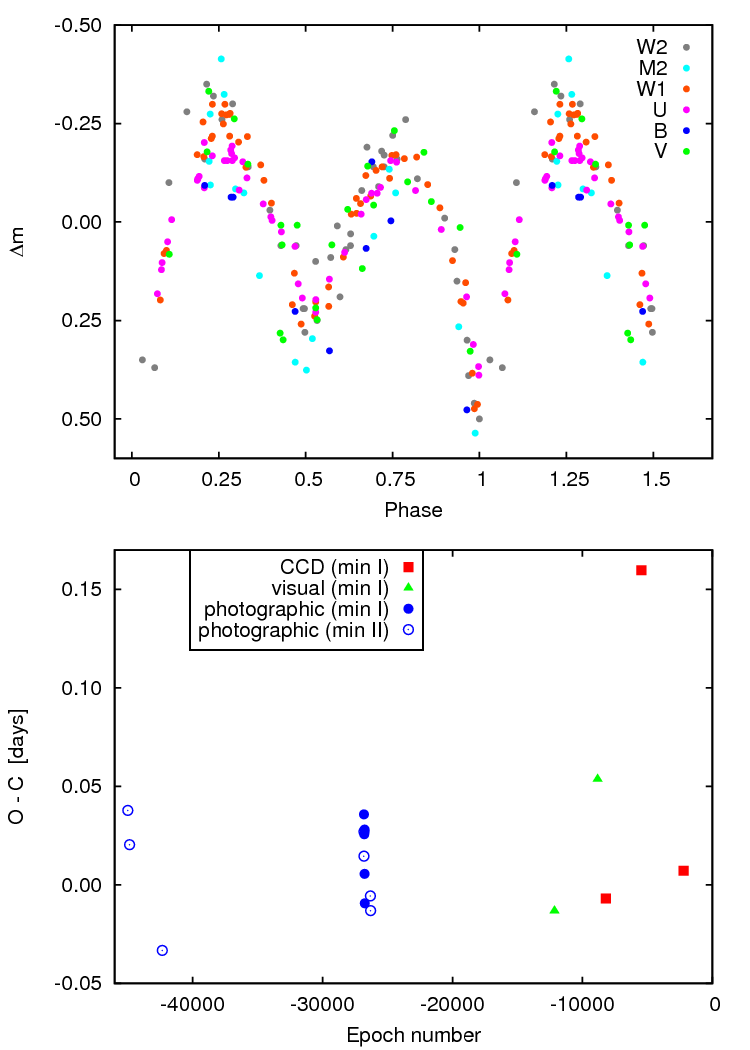"Peremennye Zvezdy",
Prilozhenie,
vol. 11, N 33 (2011)
Prilozhenie,
vol. 11, N 33 (2011)
The Variability Type and Period of V348 Aql
K. V. Sokolovsky
Max Planck Institute for Radio Astronomy, Bonn, Germany;
Astro Space Center of Lebedev Physical Institute, Moscow, Russia; and
Sternberg Astronomical Institute, Moscow, Russia
Received: 7.07.2011; accepted: 17.11.2011
(E-mail for contact: ksokolov@mpifr-bonn.mpg.de)
| ||||||||||||||||||||||
Remarks: | ||||||||||||||||||||||||||||||||||||||||||||||||||||||||||||||||||||||||||||||||||||||||||||||||||||||||||||||||||
Variability of V348 Aql was discovered by Hoffmeister (1931).
Meinunger (1966) classified it as an eclipsing binary with a period
very close to 1 day, noting however that the period and derived minima times
were uncertain due to the low variability amplitude.
As of July 2011, the O–C gateway (Paschke & Brat 2006; Paschke 2009)
lists, in addition to Meinunger's photographic data, 2 visual and 3 CCD times
of minima from Paschke (1988, 1996, 2006),
Stepan (1995), Brát et al. (2007). The data are summarized in Table 1.
V348 Aql was within the field of view of the Ultraviolet/Optical Telescope (UVOT, Roming et al. 2005) during Swift (Gehrels et al. 2004) observations of the neutron star harboring the low mass X-ray binary Aql X-1 (e.g., Miller-Jones et al. 2010) located 6' away from V348 Aql. A total of 73 observations from the Swift satellite (each consisting of one or more satellite pointings) of the Aql X-1 field were performed in 2006–2010 (Wijnands et al. 2006; Campana 2007; Maitra et al. 2010). I analyzed the Swift/UVOT data with the VaST software (Sokolovsky & Lebedev 2005) in the way similar to that described by Sokolovsky (2009). Thanks to the observations obtained from the low Earth orbit, it became clear that the actual period of V348 Aql is close to 2/3 d. The lightcurve with two wide minima of unequal depth is typical of β Lyrae (EB) systems. No significant difference in eclipse depth between the optical and ultraviolet lightcurves could be detected within the measurements accuracy (~0.05 mag). The period derived from Swift/UVOT data alone was not accurate enough to account for the historical times of minimum. Instead, it was used as a starting point for the O–C analysis, which resulted in the linear light elements presented above. The minima types, primary (I) or secondary (II), were assigned on the basis of their position on the O–C diagram for the above period (all previous observers believed they were exclusively observing primary minima). One CCD time of minimum measurement (Brát et al. 2007; observations by P. Hajek and K. Koss) is inconsistent with the suggested light elements. Since the elements describe all the historical data well, with the exception of this discrepant point, a measurement error may be suspected in this case. However, it underlines the necessity of additional observations to confirm the suggested period. The coordinates of V348 Aql were drawn from the USNO-B1.0 catalog (Monet et al. 2003). The spectral classification is by Halbedel (1984). Acknowledgments The author is grateful to Dr. V. P. Goranskij for providing his lightcurve analysis software and F. K. Schinzel for his help in translating the original publications from German. This work has made use of the Aladin interactive sky atlas, operated at CDS, Strasbourg, France, the International Variable Star Index (VSX) operated by the AAVSO, and the NASA's Astrophysics Data System. | ||||||||||||||||||||||||||||||||||||||||||||||||||||||||||||||||||||||||||||||||||||||||||||||||||||||||||||||||||
| References: | ||||||||||||||||||||||||||||||||||||||||||||||||||||||||||||||||||||||||||||||||||||||||||||||||||||||||||||||||||
| Brát, L., Zejda, M., Svoboda, P., 2007, OEJV, 74, 1
Campana, S., 2007, Astronomer's Telegram, 1087 Gehrels, N., Chincarini, G., Giommi, P., et al., 2004, Astrophys. J., 611, 1005 Halbedel, E.M., 1984, Publ. of Astron. Society of Pacific, 96, 98 Hoffmeister, C., 1931, Astron. Nachr., 242, 129 Maitra, D., Reynolds, M., Miller, J.M., Gultekin, K., 2010, Astronomer's Telegram, 2744 Meinunger, L., 1966, Mitt. veraend. Sterne, 3, 137 (the text describing V348 Aql is available electronically here) Miller-Jones, J.C.A., Sivakoff, G.R., Altamirano, D., et al., 2010, Astrophys. J., 716, 109 Monet, D.G., Levine, S.E., Canzian, B., et al., 2003, Astron. J., 125, 984 Roming, P.W.A., Kennedy, T.E., Mason, K.O., et al., 2005, Space Science Reviews, 120, 95 Sokolovsky, K., Lebedev, A., 2005, in 12th Young Scientists' Conference on Astronomy and Space Physics, Kyiv, Ukraine, April 1923, 2005, eds.: Simon, A.; Golovin, A., p.79 Sokolovsky, K.V., 2009, PZP, 9, 9 Stepan, P., 1995, Contrib. Nicholas Copernicus Obs. Planetarium Brno, 31, 4 Paschke, A., 1988, BBSAG Bulletin, No. 88, 1 Paschke, A., 1996, BBSAG Bulletin, No. 111, 1 Paschke, A., Brat, L., 2006, OEJV, 23, 13 Paschke, A., 2006, OEJV, 48, 1 Paschke, A., 2009, OEJV, 109, 43 Wijnands, R., Maitra, D., Bailyn, C., Linares, M., 2006, Astronomer's Telegram, 871 |
Light Curve
The Swift/UVOT optical-ultraviolet phased lightcurve and historical O–C diagram, both computed using the light elements presented in the Table. Data Source |